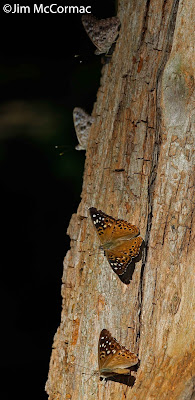Fish hatcheries can be birding hotspots, and the
St. Marys Fish Hatchery in Auglaize County has been hopping lately. Several of the ponds there have been drawn down to mudflats, attracting lots of shorebirds. I headed over last Sunday to see what I could find, and attempt to make some images. Some of my photos from this foray are in the
previous post.
The St. Marys Fish Hatchery lies just a stone's throw from the eastern shore of Grand Lake St. Marys. At the time of its construction as a canal feeder lake in the 1830-40's, this was the largest manmade lake in the world. Unfortunately, its construction drowned what must have been a spectacular wet prairie and swamp forest. But the lake, feeble substitute as it may be for the original prairies and woodlands, quickly turned into a bonanza for water birds. In 1970 Clarence Clark and James Sipe published their Birds of the Lake St. Marys Area, which documented an impressive cast of avifauna. The fish hatchery, which launched operations in 1913, provided many of these records. It attracts noteworthy birds to this day.

There are 23 ponds covering 43 acres at the hatchery, and they're normally full of water and fish. But from time to time, it becomes necessary to draw them down, such as the pond in the foreground. It's here where I spent most of my time last Sunday, and where all of the photos that follow were made.
The day prior, I had stopped at a drawn-down pond near Killbuck Wildlife Area in Wayne County, on my way back from the Lorain area. The site was attracting lots of shorebirds. As soon as I saw the situation, I knew it would be pretty much a bust for photography. The birds were too distant, and/or were in terrible light and it wasn't possible to get into a suitable situation lightwise. No matter, I stayed for several hours and enjoyed studying the birds and their interactions.
I know this fish hatchery well, though, and had a strong idea as to how I could view the birds. Departing well before dawn, I arrived at the hatchery before the sun poked above the horizon. Taking my camera rig, I holed up at the base of that cement water control structure on the side of the pond, sitting on some steps right up against the structure's wall. Positioning the tripod and camera comfortably in front of me, I waited for the sun to appear.

One of the tricks to obtaining really sharp bird photos is to get yourself close to the action. Without spooking the birds or otherwise being an annoyance. While I know the birds noticed me, my quiet presence as an extension of the water control structure did not put them off in the least. Even wary loudmouths such as Killdeer were coming within 15-20 feet of me. For the three+ hours I remained in this spot, birds were usually close at hand, unless a car or people on the road above spooked them. The light was flawless - beautiful golden early morning light coming right over my shoulder. All of the bird images in this post were made with the amazing Canon 7D Mark II, and Canon's 500mm f/4 telephoto lens. No flash was used, and as almost always I used auto white balance and evaluative metering. All images were shot with the camera in manual mode.
Note how the Killdeer's head is turned slightly towards me. That's a sweet spot for bird posture - much better than if it was looking slightly away, or even straight ahead. The settings for this photo were f/6.3; 1/1250; ISO 640. Exposure compensation was dialed down -1/3rd of a stop.
I don't like shooting over ISO 800, generally, if it can be helped. The lower the ISO number, the cleaner (less grainy or "noisy") the image. The 7D holds up quite well until about 800 or so. Even at higher ISO's its OK if you don't have to crop much. If you're not familiar with exposure compensation and how to quickly alter that on your camera, study up (Google is your friend). When left in the neutral exposure position (0 compensation), you're almost certain to overexpose bright parts, such as the white of this Killdeer's underbelly.

This Lesser Yellowlegs and a few of its brethren were so confiding that they approached TOO close for photos from time to time. Yellowlegs are exquisite sandpipers and very photogenic. I made many keepers, but liked this shot of the bird as it canted forward, scanning the mud for tiny invertebrate life. Show yourself, create a disturbance, or otherwise be conspicuous and the yellowlegs will set about scolding you loudly, and alerting every other bird on the flats. Good luck with close range studies then.
f/6.3; 1/1600; ISO 400; -2/3rd stop exposure compensation. Notice that in spite of reducing exposure compensation another one-third stop, AND increasing the shutter speed over the settings of the previous photo, my ISO reading still dropped. That's because the sun is getting higher, and feeding more light to my position. When shooting birds, especially shorebirds, I usually want to keep the shutter speed fast to freeze movement. Especially as I was interested in trying for in-flight shots, and wanted to be ready when the opportunity arises.
At one point, this little Semipalmated Sandpiper nearly scrambled over my feet. I should have spent more time with it, but did not due to other nearby distractions that I was targeting. This image is OK, but the bird's posture doesn't lend itself well to a truly stunning photo. Nothing against the sandpiper - it's beautiful - it was my fault for not spending more time tracking it and awaiting an interesting pose.
Three major aids in shooting active birds: 1) AI Servo mode (in Canon-speak). This setting allows the camera to constantly remain focused on a moving object, as long as the shutter remains half-depressed. 2) Back-button focusing. The button marked with an asterisk (*) on the back of my camera sets focus and exposure, and is controlled with my right thumb. The only thing the shutter button up front does is fire the shutter. This is a MUCH better arrangement, especially for bird photography, and I thank Dane Adams for prodding me into this setup. I wouldn't go back. Google this up and read about it. 3) Burst mode. Almost an imperative for bird shooting. Set your camera to the fastest burst rate (number of images per second). The 7D Mark II can click off 10 a second, and obviously your odds of getting a great shot go up when engaging in such photographic carpet bombing.
The Semipalmated Sandpiper was shot at f/7.1; 1/2000; ISO 640; -2/3rd stop exposure compensation.

A striking White-rumped Sandpiper seems to ponder its reflection. This species was my primary target, and I wasn't disappointed. Rick Asamoto had reported a good-sized flock here prior, hence my trip. As many as 75 white-rumps were present during my stay, and as often as not they were in very close proximity. This is truly a feathered globetrotter. They breed in the highest reaches of the Alaskan and Canadian arctic. In an incredible journey, the white-rumps migrate all of the way to the Atlantic coast of southern South America, with many making it all of the way to Tierra del Fuego in southern Argentina. The animal in this photo is likely to travel 8-9,000 miles in its southward migration. Making it all the more remarkable is that it - and all of the others that turned up in Ohio this October - are juveniles. The adults have preceded them. Built-in GPS allows the youngsters to navigate unerringly from one end of the earth to the other, having never made the journey before, and with no parental guidance.
This image was made at f/7.1; 1/2000; ISO 800; -2/3rd stop exposure compensation.
A squadron of White-rumped Sandpipers settles onto the mudflat. While foraging on the flats, the birds scurry about like feathered mice, and perhaps to some - at least those ignorant of their amazing story - would not appear overly impressive. But in flight the birds are transformed. Long strong wings provide an impressive wing surface to body mass ratio, and the animals are swift, graceful, and direct. Some legs of the white-rumps' journey might last for three days aloft nonstop, and cover 4,500 miles. Fueling way stations such as this mudflat, that offer an abundance of fat and protein filled animal life, are imperative to their success.
Shooting flying birds is, needless to say, a bit trickier than a bird at rest. Especially when they are fast flyers prone to erratic jigs and jags. The idea is to smoothly track the bird or flock, ideally when they are far out, and keep them in your sights and in focus until they get into shooting range. Just as in skeet-shooting, smoothly depress the shutter (trigger) while all the while tracking the moving birds. This image was made at f/7.1; 1/2000; ISO 400; -2/3rd stop exposure compensation.
This White-rumped Sandpiper took a rare breather from its normally frenetic feeding, and sat for a minute looking around. For photographic purposes, its posture was sublime - facing slightly away, but obligingly looking back slightly over its shoulder towards the camera. By the time you read this, there's a good chance the bird will already be in South America.
This shot was made at f/6.3; 1/2000; ISO 640, -2/3rd stop exposure compensation.
After about three and a half hours frozen in place tucked up against the water control structure, it was time for a stretch and a look around the rest of the hatchery. When I circled back to the mudflat pond an hour and a half later, the pump had been activated and water was rushing over the flats. Back to the fish business, but there were several other drained ponds that hosted shorebirds. Nonetheless, my timing was fortuitous indeed, and as they say, the early bird gets the worm.

























